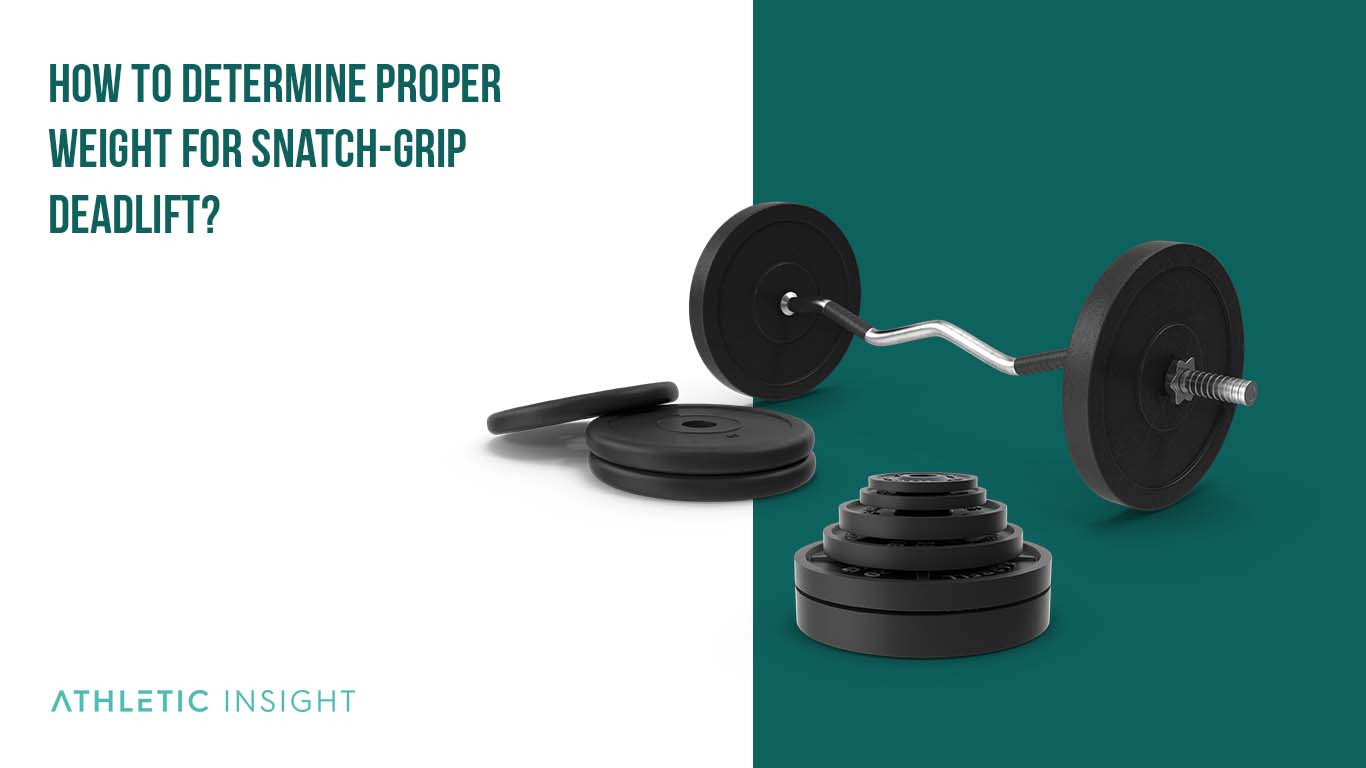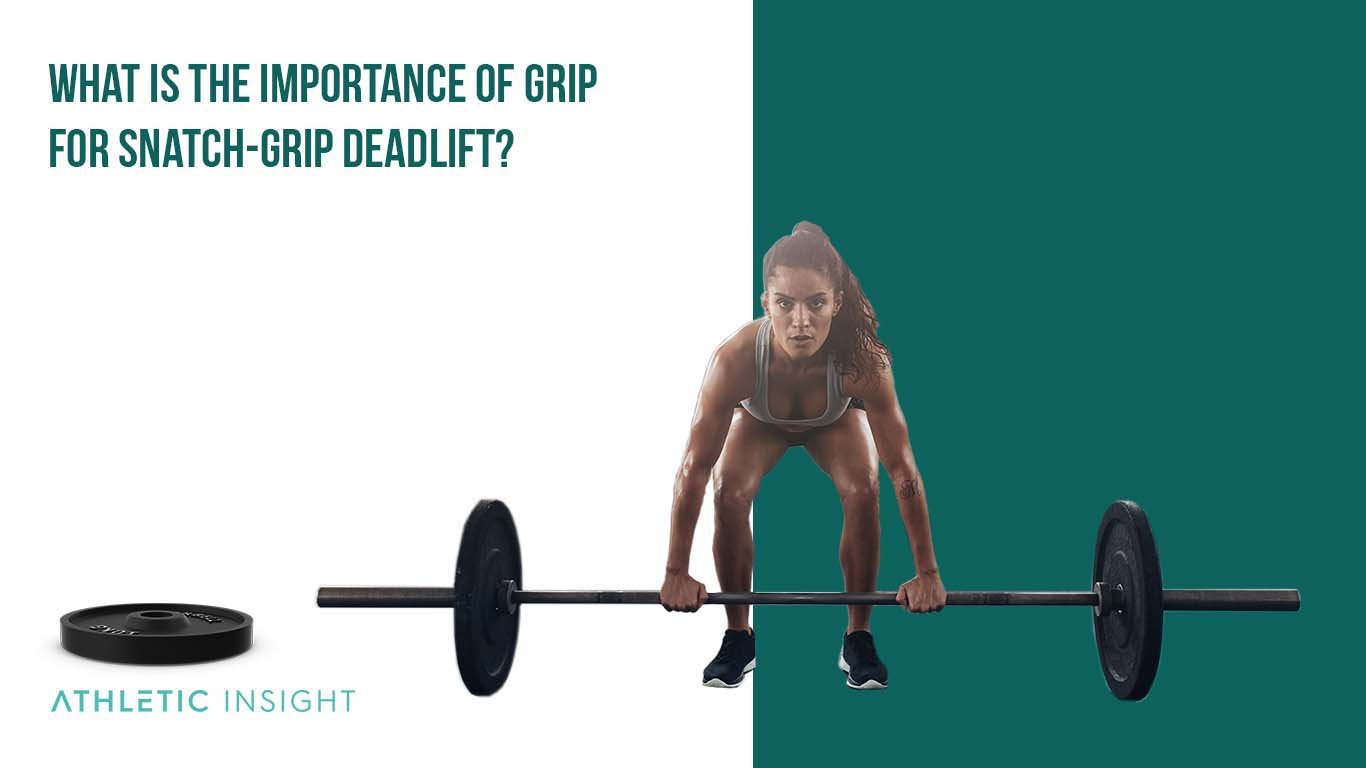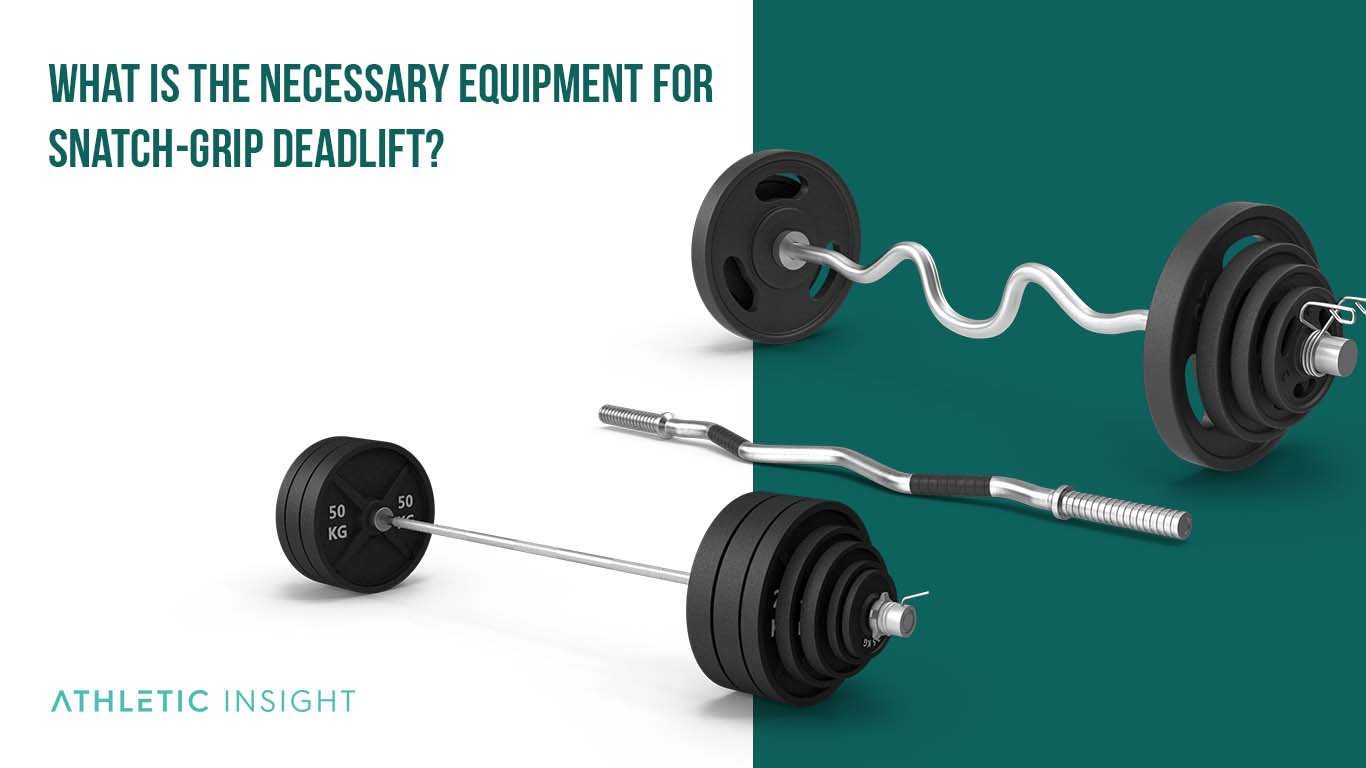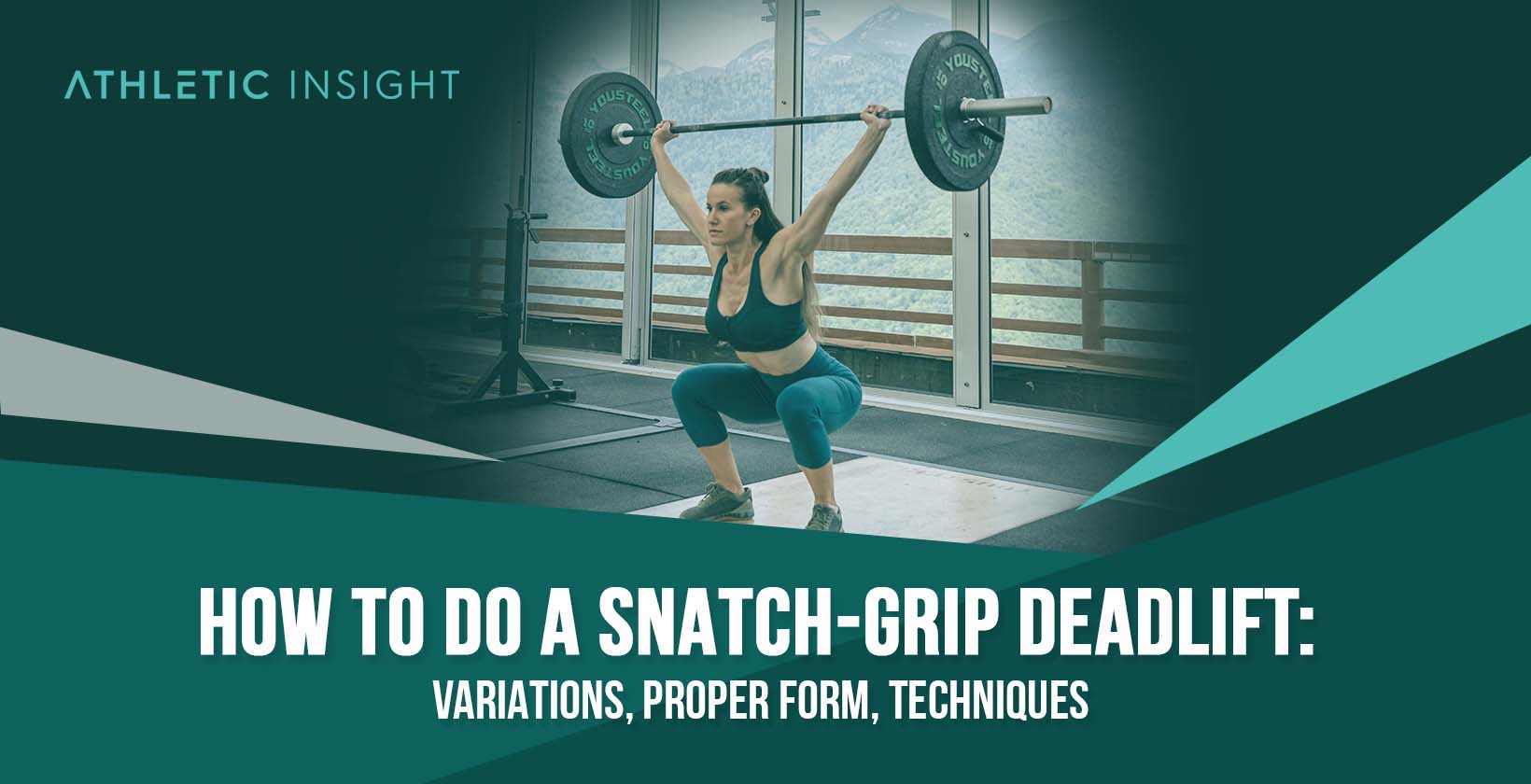A snatch grip deadlift is an alternate type of deadlift that is performed by taking a broader grip on the barbell. By keeping your hands further apart, you work different muscles and ease pressure on your lower back.
The snatch-grip deadlift benefits the individual performing the lift because it strengthens your upper back, increases lower body hypertrophy, improves your standard deadlift, strengthens your grip, increases trapezius strength, and increases back rigidity.
Similar to other deadlift variations, the snatch-grip deadlift involves four main steps; the setup, the initiation of the lift, the initial pull, the primary pull, and the finish or lock out.
Like all weighted exercises, the deadlift can be harmful and even dangerous if not performed correctly. Common mistakes include rolling the shoulders, having your arms spread out too far, and lifting with only one part of your body.
This snatch grip deadlift guide will discuss proper form, benefits, appropriate weight, how to master the snatch grip deadlift, and variations of this lift. Keep reading to make sure you get the most out of this weight lifting exercise.
How To Perform Snatch-Grip Deadlift With Proper Form
Although the snatch grip deadlift is an Olympic lift and one of best back exercises, any individual can achieve proper form. Before attempting a snatch grip deadlift, you should adequately prepare for the exercise.
You should have a wide grip on the barbell throughout the movement, and your arms should remain extended. Additionally, your feet should be hip-width apart and be pointed slightly towards the barbells.
To determine the proper grip, you should put your arms by your side and raise your elbows to shoulder level. This should create a 90-degree angle at your elbows. Next, you should straighten your arms. Your final hand spacing correctly positions your arms for a snatch grip deadlift.
1. Set-Up
Approach the bar and place your feet about a hip-width apart. The barbell should be over the center of your feet.
2. Initiating the Deadlift
The snatch grip deadlift should be performed using a double overhand grip. You should place your hands on the bar.
Next, you should sink into the loaded position (hands on the bar, knees bent, and hips slightly above the knees).
Now, you should flex your back and pull your chest and hips up. Finally, you should draw a straight line between your feet, the barbell, and shoulders.
3. Initial Pull
You begin the snatch grip deadlift by pulling your back, arms, and trapezius muscles. At the same time, you should be pushing into the ground evenly with your feet.
You should feel pressure evenly distributed on your feet. Additionally, you should not be leaning forward or backward. The pull should be straight up.
4. Primary Pull
As you begin to pull the barbell upwards, you must keep your chest high and out. Additionally, the barbell should be held as close to your legs as possible.
As you begin to straighten out, keep the barbell as close to your shins as possible. Moving the weight too far away from the body can cause you to lose your balance and potentially injure yourself.
5. Finishing the Deadlift
Once you are standing straight up, your arms should be straight, your chest high, and the backside of your body should be flexed. Next, you should pull back your shoulders and keep your trapezoids engaged.
While keeping the backside of your body tight, you should lower the barbell the same way that you lifted it. The weight should be lowered in a slow and controlled motion.
Practicing this form can help even a new weightlifter master the snatch-grip deadlift.
What Are the Benefits of Snatch-Grip Deadlift?
The snatch grip deadlift is an excellent exercise because it works out different muscle groups all in one movement. Many weight lifting exercises only work out one part of the body. The snatch grip deadlift is a one-stop shop.
There are many benefits of the snatch-grip deadlift.
- Helps you strengthen your upper back.
- Increases lower body hypertrophy.
- Helps you improve your standard deadlift.
- Applies for Olympic Lift.
- Strengthens your grip.
- Increases back strength.
- Increases back rigidity.
What Are the Mistakes for Snatch-Grip Deadlift Form?
The snatch grip deadlift is a compound lift. That means that it requires multiple movements to complete. This makes it a more complicated lift, and as a result, many weightlifters make mistakes in their form. Mastering the snatch-grip deadlift form is essential to prevent injury and maximize the impact of this exercise.
Below are several common mistakes you can make when performing a barbell snatch grip deadlift. As you master the snatch grip deadlift, you should avoid these easy mishaps.
1. Lifting With One Part of the Body
The snatch grip deadlift is a compound lift. A compound lift requires multiple movements and multiple muscles. The back, glutes, and quads should all be engaged while completing this lift. Unfortunately, many athletes put too great an emphasis on one part of their body while performing a deadlift.
This is frequently the back, but it can also be the glutes or the hamstrings. Lifting with only one part of the body can create muscle imbalances, but it can also cause injury. Good snatch-grip deadlift form requires you to lift all muscle groups in unison.
2. Rolling the Shoulders Forward
Even though the snatch grip deadlift is a lower body exercise, snatch-grip deadlift techniques are good to emphasize upper body form. Many athletes will roll their shoulders forward and point their chest down. This can cause a rounded back, putting a lot of stress on your spine and surrounding muscles.
This additional lumbar stress can cause back injury. Back injury is one of the most common snatch grip deadlift mistakes, and one of the most difficult to recover from.
3. Widening the Grip
The handgrip on a snatch-grip deadlift is wide. However, if you make your grip too wide, this can put additional stress on your back. It can also make the lift more difficult.
As a general rule, your hands should not be touching the ends of the barbell. There should be at least an inch between the weight plates and your hands.
How To Determine Proper Weight for Snatch-Grip Deadlift?
Determining the proper weight for a snatch grip deadlift is essential for increasing strength and, more importantly, ensuring safety. Attempting to snatch grip deadlift too much weight can be dangerous and lead to injury.

If you are new to weight lifting, start small. It is more important to master the snatch-grip deadlift and use proper form than lift considerable weight. If you are a beginner, it is recommended that you start light with 20-30 pounds and master the form first.
Once you’ve become proficient with the snatch-grip deadlift, you can increase the weight to an appropriate level. When completing a snatch-grip deadlift, the lift should be challenging, but you should be able to complete a set of five. Experiment with increasing amounts until you find a weight appropriate for your strength level.
The snatch-grip deadlift is more challenging since it requires a wider arm grip. An experienced weight lifter should do snatch-grip deadlifts with 70-80% of what they can deadlift to adjust for the wider grip.
What Is the Importance of Grip for Snatch-Grip Deadlift?
The grip is one of the most important aspects of proper snatch-grip deadlift form. Improper grip can make the exercise much more complex and even dangerous. The grip is defined as the hand position that you use while completing an exercise.

Widening the grip sets a snatch-grip deadlift apart from a regular deadlift. The form for these two exercises is different, so you must have the appropriate grip to use the proper form.
While it is a greater challenge, the snatch-grip deadlift also puts a more significant load on the lifter’s back muscles. If the lifter’s grip is too broad, too much stress will be placed on their back, making the exercise riskier than it should be.
Which Muscles Are Involved While Performing Snatch-Grip Deadlift?
Proper snatch-grip deadlift techniques work a wide variety of muscles. That is some of what makes this exercise so popular and effective. Unfortunately, the snatch-grip deadlift does not work with mirror muscles.
1. Latissimus Dorsi & Trapezius Muscles
Also known as your lats and traps, these two muscle groups are located in your upper back. They are engaged throughout a snatch-grip deadlift because of the wide hand grip. These two muscle groups are used to keep the barbell in the appropriate position.
Adding the snatch-grip deadlift to your routine can increase the strength of these two muscle groups.
2. Gluteus Maximus
Also known as the glutes or your butt, this muscle group engages throughout a snatch-grip deadlift. This is one of the most active muscle groups in this exercise and is used to keep your upper and lower body aligned and help you straighten your hips at the end of the lift.
3. Hamstrings
The hamstrings are above the knee and are one of the most important muscle groups in the body. In the case of a snatch-grip deadlift, the hamstrings help you lift the barbell vertically and straighten your legs. Additionally, the hamstrings and the glutes help you straighten your hips at the end of the lift.
If you are interested in working out your hamstrings, a Romanian deadlift can be an excellent alternative to the snatch-grip deadlift.
4. Erector Spinae
The erector spinae are lower-back muscles. The wider hand grip used in the snatch-grip deadlift puts additional tension on the lower back. Completing this exercise using the proper form can strengthen the lower back.
5. Forearms
Even though the snatch-grip deadlift is primarily a lower-body exercise, the forearms benefit. The wider hand grip used in the snatch-grip deadlift makes it much more difficult for you to get a firm grip on the barbel. As a result, this exercise helps increase grip and forearm strength.
How To Master Snatch-Grip Deadlift?
You can follow these six steps if you are ready to dominate the snatch-grip deadlift. Each of these steps is essential to correctly completing a snatch-grip deadlift.
1. Determine your position.
Before lifting the barbell, you must appropriately position yourself. You should approach the barbel with your feet about a hip-width apart. Your feet should be slightly pointed towards the weights. You should be at the center of the barbell, and the bar should be over the center of your foot.
Determining your position ensures that you will be balanced as you perform this lift.
2. Set your grip.
After you have positioned yourself, the next step is to establish the proper grip on the bar. This step is essential because, without a good grip, you might drop the bar and not complete the exercise.
Your hands should be at least an inch from the weight on each end of the barbell. You should establish a secure and comfortable grip with both hands.
3. Hold your shins against the bar.
Now that you have positioned yourself appropriately and have a good grip, the next step is to load your body and put your shins against the bar. Placing your shins against the bar ensures that the weight is close to your body.
If the weight is too far away, this will put too much stress on your back, making this exercise more challenging. Additionally, by holding their shins against the bar, you appropriately load your body to lift the barbell.
4. Feel the muscle.
You are now ready to lift the barbell. You should begin to pull on the barbel upward while pushing down with your feet. You should “feel” your muscles start to flex. This step is essential because you can check your form. If one group of muscles is not being used, you know your form is inappropriate.
5. Pull the bar up and around your body.
Once you feel your muscles engaged, you should pull the bar up and around your body. This is the most challenging part of the snatch-grip deadlift. You must pull the weight up while pushing your feet down.
6. Stand tall at the end of the snatch-grip deadlift rep.
To end the snatch-grip deadlift, you must straighten your knees and stand tall. This is an essential last step because it ensures that you complete the exercise. If you do not stand tall, you might be only doing part of the exercise.
What Are the Snatch-Grip Deadlift Variations?
The snatch-grip deadlift is an excellent exercise. There are many variations of this superb exercise that target different muscles than the standard barbell snatch-grip deadlift. Some of the popular variations of snatch grip deadlift are listed below.
1. Deficit Snatch-Grip Deadlift
The deficit snatch-grip deadlift adds challenge to the classic snatch-grip deadlift. When completing this variation, the grip and form are the same. However, the deficit snatch-grip deadlift is completed while standing on an elevated platform. This can take the form of a box or several plates.
The platform adds extra distance that your body has to move the weight. It combines the squad and snatch-grip deadlift into one exercise.
2. Snatch-Grip Deadlift with Pause in Pull
The snatch-grip deadlift with a pause in pull is another variation of the classic snatch-grip deadlift. This variation has the same form, grip, and technique as the deficit snatch-grip deadlift. However, it adds a pause midway through the lift.
The pause can occur at any point of the deadlift. The delay will help you improve your strength during that specific portion of the exercise. This variation is like a combination of a snatch-grip deadlift and a plank.
3. Clean-Grip Deadlift
The clean-grip deadlift is another variation of the snatch-grip deadlift. It is also an Olympic power lift. The significant difference between the snatch-grip and clean-grip deadlift is in the grip. In a clean-grip deadlift, you place your hands a shoulder apart on the barbell.
Changing the hand position allows you to deadlift more weight. This is a simpler version of the deadlift and helps perfect form.
4. Snatch-Grip Bent-Over Row
The snatch-grip bent-over row features the same hand position as the snatch-grip deadlift. However, this variation strengthens the lower back, lats, and traps. During a snatch-grip bent-over row, the barbel starts from an elevated position, so the lower legs do not have to work in this variation.
5. Snatch-Grip Romanian Deadlift
The snatch-grip Romanian deadlift is similar to the snatch-grip deadlift. The only difference is that a Romanian deadlift starts from a standing position and exercises the body by slowly lowering the weight. A traditional snatch-grip deadlift moves in the opposite direction.
The snatch-grip Romanian deadlift emphasizes your glutes and hamstrings.
6. Trap Bar Snatch-Grip Deadlift
The trap bar snatch-grip deadlift features a different type of bar in comparison to the snatch-grip deadlift. The trap bar is also known as a hex weight lifting bar. The trap bar forces your quads to do more work and your lower back to do less work. This is a great variation if you have lower back problems or target your quads.
What Is the Necessary Equipment for Snatch-Grip Deadlift?
You need some essential equipment to complete a snatch-grip deadlift. To begin with, add a barbell and some weights to your routine. You can use either traditional weights or rubber bumper weights. Additionally, it’s prudent to have safe shoes for a snatch-grip deadlift to maintain balance.

Which Muscles Can Be Affected More From Snatch-Grip Deadlift?
The snatch-grip deadlift is primarily a lower-body and back exercise. The following muscle groups are targeted in this exercise.
- Lats
- Traps
- Glutes
- Hamstrings
- Lower Back
- Forearms
The glutes, hamstrings, and lower back are affected the most. These muscle groups are primarily responsible for lifting the weight. The lats, traps, and forearms are less affected by this exercise because they stabilize muscles.
What Is the Effectiveness of Snatch-Grip Deadlift for Muscle Growth When Compared to Squats?
The snatch-grip deadlift and squat are both exercises that can help promote muscle growth. Although similar, these two exercises target different muscle groups. The snatch-grip deadlift promotes better muscle growth in the lats and traps compared to the traditional squat.
The snatch-grip deadlift aids growth by breaking down your muscles. After a workout, the body has to repair muscle tissue damaged while exercising. This process creates new muscle strands, also known as myofibrils.
Over time, myofibrils will increase the thickness and density. The repair of the muscle fibers causes your muscles to grow bigger after working out.
What Are the Snatch-Grip Deadlift Related Facts?
The snatch-grip deadlift has a broader range of motion than a standard deadlift. Also, the snatch-grip deadlift targets your lats and traps in addition to your lower body.
Does Snatch-Grip Deadlift Affect the Hormones?
Yes, the snatch-grip deadlift can cause your body to increase growth hormone production and generate more testosterone. Both growth hormone and testosterone help repair the body after exercising.
Cortisol is also produced when performing a snatch-grip deadlift. Cortisol helps your body generate energy. However, this is achieved by consuming tissue. Keeping your cortisol levels low by resting between sets of snatch-grip deadlifts is essential.
Does Snatch-Grip Deadlift affect the Mood?
Yes, performing the snatch-grip deadlift can affect your mood. The snatch-grip deadlift and exercise, in general, affect your brain. Exercise can improve your sleep, and improved sleep can improve your mood.
Is Snatch-Grip Deadlift Practiced Within Crossfit?
Yes, the snatch grip deadlift is a popular exercise in Crossfit.
Is Snatch-Grip Deadlift a Military Movement?
No, the snatch-grip deadlift is not a military movement.
Is Snatch-Grip Deadlift Dangerous?
No, the snatch-grip deadlift is not dangerous as long as you use the proper form and lift an appropriate amount of weight.
Is Snatch-Grip Deadlift Essential?
Yes, many consider the snatch-grip deadlift an essential weight lifting exercise.
Is Snatch-Grip Deadlift an Olympic Lift?
Yes, the snatch-grip deadlift is an Olympic lift.
Which Is Better, the Snatch-Grip Deadlift or Conventional Deadlift?
The snatch-grip deadlift is better than the conventional deadlift. Both are good exercises, but the snatch-grip deadlift has several distinct advantages.
A conventional deadlift is a good compound exercise that works the lower body. The narrower grip makes this a more accessible lift to complete. Additionally, you can lift more weight when completing a conventional deadlift.
On the other hand, a snatch-grip deadlift has several advantages. It works the upper back. Additionally, the snatch-grip deadlift has a more extensive range of motion and can help improve hip mobility. The only disadvantage of the snatch-grip deadlift is that the form is more complicated and needs to be practiced before being performed.
With this guide on the snatch-grip deadlift, you’ll be better equipped to incorporate this exercise into your weight lifting routine. As long as you use proper form, you’ll find this exercise to be invaluable in meeting your weight lifting goals.



